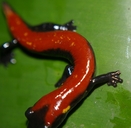|
Bolitoglossa splendida Boza-Oviedo, Rovito, Chaves, García-Rodríguez, Artavia, Bolaños & Wake, 2012
Splendid Web-footed Salamander Subgenus: Eladinea | family: Plethodontidae subfamily: Hemidactyliinae genus: Bolitoglossa |
| Species Description: Boza-Oviedo E, Rovito SM, Chaves G, Garcia-Rodriguez A, Artavia LG, Bolanos F, Wake DB 2012. Salamanders from the eastern Cordillera de Talamanca, Costa Rica, with descriptions of five new species (Plethodontidae: Bolitoglossa, Nototriton, and Oedipina) and natural history notes from recent expeditions. Zootaxa 3309: 36- 61. | |
 © 2012 Alex Monro and Eduardo Boza (1 of 7) |
|
|
|
Description DIAGNOSIS: Bolitoglossa splendida is close in size to other Bolitoglossa species like B. gomezi, B. pesrubra, and B. subpalmata. However, it has a relatively broad head that differentiates from B. bramei, B. gracilis, B. gomezi, B. pesrubra, B. subpalmata, and B. tica (Boza-Oviedo et al. 2012). COLORATION: Bolitoglossa splendida is jet black coloration on the dorsal and lateral areas but paler on the ventral area. There is a dorsolateral band, varying between bright red or orange-red, that begins on the back of the head and extends to the base of the tail. The band is split at the base of the head into two stripes that extend to the back of the eyelids. The nasolabial protuberances are pale in contrast to the black coloration of the skin. The band has no breaks in it but has some melanin speckling. The lateral edge of the band is irregular. Bright yellow spots can be observed unevenly distributed on the lateral and ventrolateral surfaces (Boza-Oviedo et al. 2012). Distribution and Habitat Country distribution from AmphibiaWeb's database: Costa Rica
Life History, Abundance, Activity, and Special Behaviors Other vegetation in this species' habitat is dominated by members of the Araceae, Heliconiaceae, Marantaceae, Begoniaceae, Acanthaceae, Arecaceae, Commelinaceae, Rubiaceae, Urticaceae, Melastomataceae, Bromeliaceae, Ericaceae, and Piperaceae families along with bryophytes and ferns (Boza-Oviedo et al. 2012). Trends and Threats Possible reasons for amphibian decline General habitat alteration and loss Comments PHYLOGENETIC RELATIONSHIPS: Based on Bayesian and Maximum Likelihood analyses on 16S and cyt b mtDNA, B. spendida, forms a polytomy with B. gomezi, the clade composed of B. bramei, B. kamuk, and B. pesrubra, and the clade composed of B. gracilis, B. subpalmata, and B. tica (Boza-Oviedo et al. 2012). ETYMOLOGY: The species epithet, “splendida” comes from the Latin word, “splendidus,” which means “distinctly vivid in appearance” (Boza-Oviedo et al. 2012).
References
Boza-Oviedo, E., Rovito, S.M., Chaves, G., Garcia-Rodriguez, A., Artavia, L.G., Bolanos, F., Wake, D.B. (2012). ''Salamanders from the eastern Cordillera de Talamanca, Costa Rica, with descriptions of five new species (Plethodontidae: Bolitoglossa, Nototriton, and Oedipina) and natural history notes from recent expeditions.'' Zootaxa, 3309, 36 - 61. Feldmeier, S., Schefczyk, L., Wagner, N., Heinemann, G., Veith, M., Lötters, S., Gratwicke, B. (2016). “Exploring the distribution of the spreading lethal salamander chytrid fungus in its invasive range in Europe - a macroecological approach.” PloS one, 11(10), e0165682. [link] IUCN SSC Amphibian Specialist Group. (2020). "Bolitoglossa splendida." The IUCN Red List of Threatened Species 2020: e.T50927240A50927269. https://dx.doi.org/10.2305/IUCN.UK.2020- 3.RLTS.T50927240A50927269.en Downloaded February 2022 Originally submitted by: Megan Swanson, Ernest Walker (2022-05-18) Description by: Megan Swanson, Ernest Walker (updated 2022-05-18)
Distribution by: Megan Swanson, Ernest Walker (updated 2022-05-18)
Life history by: Megan Swanson, Ernest Walker (updated 2022-05-18)
Trends and threats by: Megan Swanson, Ernest Walker (updated 2022-05-18)
Comments by: Megan Swanson, Ernest Walker (updated 2022-05-18)
Edited by: Ann T. Chang (2022-05-18) Species Account Citation: AmphibiaWeb 2022 Bolitoglossa splendida: Splendid Web-footed Salamander <https://amphibiaweb.org/species/7819> University of California, Berkeley, CA, USA. Accessed May 6, 2025.
Feedback or comments about this page.
Citation: AmphibiaWeb. 2025. <https://amphibiaweb.org> University of California, Berkeley, CA, USA. Accessed 6 May 2025. AmphibiaWeb's policy on data use. |



 Raffaëlli Account
Raffaëlli Account Map of Life
Map of Life